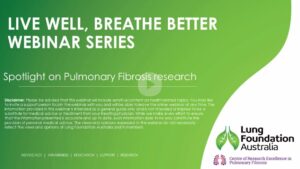Presented by Prof. Tamera Corte, Prof. Dan Chambers and Prof. Jo Dickinson. This video provides an overview and panel discussion on the latest research projects in PF, including genetic research, drug developments and clinical trials.
Pulmonary fibrosis is an umbrella term for various lung diseases that cause inflammation or fibrosis (scarring) of lung tissue. This condition can be seen on CT scans and biopsies, often showing progressive destruction or “honeycombing” of the lung tissue. Idiopathic pulmonary fibrosis (IPF) is a progressive disorder with variable progression rates among patients. Early diagnosis and intervention are crucial as the disease progresses similarly regardless of initial severity.
The incidence of pulmonary fibrosis is increasing, possibly due to better diagnostic tools like CT scans. Recent developments have improved our understanding of the disease’s mechanisms. A significant advancement is the recognition of “progressive pulmonary fibrosis,” which includes various types of pulmonary fibrosis that worsen over time.
Anti-fibrotic medications, such as nintedanib, have been shown to slow the disease’s progression. These medications are now available on the Pharmaceutical Benefits Scheme (PBS) in Australia for treating progressive pulmonary fibrosis. Despite these advancements, there remains a gap between patient needs and available treatments, highlighting the importance of ongoing research.
Australia has made significant strides in pulmonary fibrosis research, supported by government grants and coordinated efforts through the Centre of Research Excellence in Pulmonary Fibrosis (CRE-PF). The CRE-PF focuses on basic and clinical research, clinical trials, and education. It includes a national registry, biobank, and clinical trials network to support research and improve patient outcomes.
Key research areas include novel diagnostic techniques, such as artificial intelligence applied to CT scans, and the identification of biomarkers to predict disease outcomes. Genetic research is also advancing, with studies identifying genetic variants associated with pulmonary fibrosis, which may lead to targeted therapies.
Clinical trials are ongoing, exploring new treatments and management strategies. These include trials on portable oxygen, high-intensity pulmonary rehabilitation, and self-management apps. The CRE also emphasises translating research into clinical practice and improving care standards across Australia.
Overall, the mission is to transform and extend the lives of patients with pulmonary fibrosis through collaborative research and innovative treatments.
Was this page helpful?
Good job! Please give your positive feedback
How could we improve this post? Please Help us.
